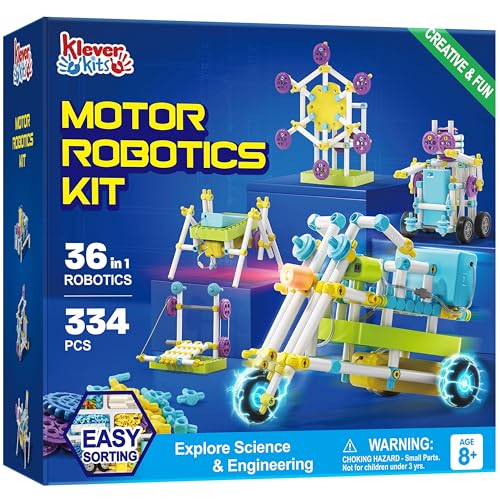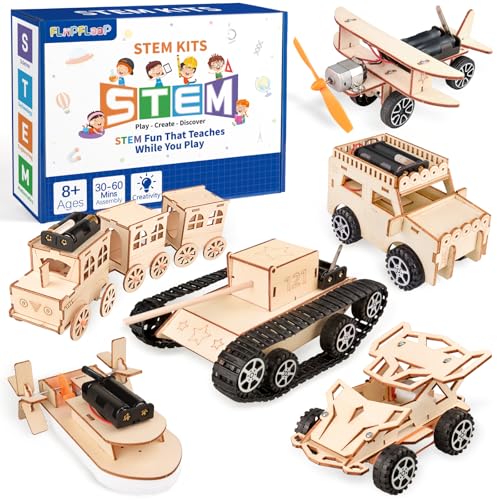If you’re looking for the best educational STEM kits for kids that make learning fun, I’ve got some great options to share. From snap-together electronics, solar robot building, and chemistry sets to earth science and engineering kits, these hands-on projects inspire curiosity and skill development. Each kit is designed for different ages and interests, promoting creativity and problem-solving. Keep exploring, and you’ll find the perfect kit to ignite their love for science and innovation.
Key Takeaways
- Highlights a diverse selection of STEM kits catering to various ages, interests, and educational focuses, including electronics, robotics, earth science, and art.
- Emphasizes hands-on, interactive learning experiences that foster creativity, problem-solving, critical thinking, and environmental awareness.
- Details key features like easy assembly, durability, safety, and included instructions to promote engaging, screen-free educational play.
- Addresses potential challenges such as component size, assembly difficulty, and weather dependence to help parents select suitable kits.
- Showcases how these kits enhance STEM skills through real-world applications, inspiring curiosity and future interest in science and engineering.
Snap Circuits Jr. SC-100 Electronics Exploration Kit
If you’re looking for an engaging and safe way to introduce kids to electronics, the Snap Circuits Jr. SC-100 is perfect. I love how it includes over 30 color-coded, real circuit components that snap together easily—no soldering or tools needed. Kids can build more than 100 projects, from musical doorbells to police sirens, which makes learning fun and hands-on. The clear instructions and large illustrations in the manual help kids understand how devices like radios and TVs work. It’s a great way to spark curiosity, develop problem-solving skills, and foster creativity—all in a safe, durable, and kid-friendly package.
Best For: children aged 8 and above who are interested in exploring electronics, STEM learning, and hands-on building projects.
Pros:
- Easy snap-together components that require no soldering or tools, making it safe and user-friendly for kids.
- Offers over 100 engaging projects that promote problem-solving, creativity, and understanding of electronic concepts.
- Durable parts and clear, illustrated manual enhance learning, reusability, and enjoyment.
Cons:
- Requires two AA batteries (not included), which may be an extra step for setup.
- Limited to basic components, so advanced electronics projects may require additional upgrade kits.
- Some children might outgrow the simple projects quickly and seek more complex electronics kits.
Sillbird 12-in-1 Solar Robot Building Kit
The Sillbird 12-in-1 Solar Robot Building Kit is an excellent choice for kids aged 8 to 13 who enjoy hands-on STEM activities and want to explore renewable energy concepts. With 190 pieces supporting the construction of 12 different models, it encourages creativity, engineering, and problem-solving. Powered by a solar panel, it demonstrates renewable energy principles, making learning interactive and fun. The clear instructions help kids build independently or with family, fostering screen-free play. While some parts can be tricky to assemble and the solar function depends on sunlight, it’s a great introduction to robotics and sustainability for curious young learners.
Best For: children aged 8 to 13 interested in hands-on STEM learning, renewable energy concepts, and creative robot building.
Pros:
- Encourages creativity, engineering skills, and problem-solving through 12 different models.
- Promotes environmental awareness by demonstrating renewable energy with a solar panel.
- Supports independent or family assembly with clear, step-by-step instructions.
Cons:
- Some parts can be difficult to remove from mold sheets, requiring extra tools and patience.
- The solar-powered movement is highly weather-dependent and may not work well indoors or on cloudy days.
- Assembly can be challenging due to poorly fitting parts, fragile components, and potential for breakage.
Poraxy 4 in 1 STEM Kits for Kids
Poraxy 4 in 1 STEM Kits are perfect for kids aged 6 to 13 who love hands-on learning and creative projects. I’ve found these kits to be excellent for sparking curiosity through building mini ferris wheels, carousels, fiber optic lamps, and star night lights. Made from high-quality, laser-cut wood with smooth edges, they’re safe and durable. Kids can personalize their models with paint and decorations, boosting creativity. Plus, these kits promote STEM skills like circuit building and electrical engineering, making learning fun and engaging. They’re great as gifts or educational tools at home or school, combining play with valuable scientific concepts.
Best For: children aged 6 to 13 who enjoy hands-on STEM activities, creative building, and educational crafts.
Pros:
- Made from high-quality, laser-cut wood with smooth edges for safety and durability
- Encourages creativity through painting and decorating, making each project unique
- Promotes STEM learning with projects involving electrical circuits, engineering, and coding
Cons:
- Assembly may require adult supervision for younger children
- Limited to certain models like ferris wheels, carousels, and lighting projects, which might limit variety for some kids
- May need additional batteries or tools not included in the kit for complete setup
NATIONAL GEOGRAPHIC Earth Science Kit for Kids
Looking for a STEM kit that sparks curiosity about earth sciences? The NATIONAL GEOGRAPHIC Earth Science Kit for Kids is fantastic. It offers over 100 experiments, like crystal growing, volcano eruptions, and rock collection. The kit includes everything needed for 15 experiments and a case to store minerals. Plus, a bonus guide with 85+ activities using household items keeps kids exploring. Recognized for quality, it’s perfect for ages 8 and up, fostering hands-on learning, curiosity, and creativity. Kids love the variety, and parents appreciate the educational value. It’s a well-organized, engaging way to plunge into geology and earth science.
Best For: children aged 8 and above who have a curious mind and enjoy hands-on science activities related to earth sciences and geology.
Pros:
- Offers over 100 experiments to keep kids engaged and learning.
- Includes a comprehensive guide with 85+ additional activities using household items.
- Recognized for high quality and educational value, fostering STEM interest.
Cons:
- Some users have reported missing gemstones in the kit.
- The initial stiffness of magnetic putty may require play to soften.
- The size and weight (8.66 x 3.15 x 12 inches, 1.61 pounds) may be slightly bulky for storage or transport.
60+ Science Experiment Kit for Kids Ages 5-8, STEM Educational Science Gifts
For parents and guardians seeking a fun, educational way to spark curiosity in young children, the Science Experiment Kit for Kids Ages 5-8 stands out as an excellent choice. With over 60 engaging experiments like volcanic eruptions, dinosaur egg digging, and lava lamps, it offers a hands-on STEM experience that’s both exciting and educational. The kit includes all necessary materials, tools, safety goggles, and clear instructions, allowing kids to explore science independently or with help. It promotes curiosity, critical thinking, and problem-solving skills, making learning enjoyable. Perfect for birthdays, holidays, or summer activities, it fosters a lifelong interest in science from a young age.
Best For: parents, guardians, and educators looking for an engaging, educational STEM activity kit to inspire curiosity and learning in children aged 5-8.
Pros:
- Contains over 60 fun and hands-on experiments that stimulate early science exploration
- All necessary materials, tools, safety goggles, and clear instructions included for easy use
- Promotes critical thinking, problem-solving, and curiosity in young learners
Cons:
- Some experiments may require adult supervision for safety or guidance
- The variety of experiments might be overwhelming for very young children or beginners
- Limited to children within the age range of 5-8, less suitable for older or younger kids
Klever Kits 36-in-1 Motor Robotic Kits for Kids
If your child is fascinated by robotics and enthusiastic to build multiple models, the Klever Kits 36-in-1 Motor Robotic Kits stands out as an excellent choice. With the ability to create 36 different models, including walking machines and racing cars, it offers endless hands-on fun. The organized parts tray makes setup easy, while the detailed instructions and video tutorials simplify assembly. Made from safe, durable materials, it’s perfect for kids aged 8-13, promoting problem-solving, engineering skills, and teamwork. This kit provides a screen-free, educational experience that sparks curiosity and perseverance, making it a fantastic gift that combines learning and play.
Best For: children aged 8-13 who are interested in robotics, engineering, and hands-on STEM learning.
Pros:
- Offers 36 different models to build, including motorized robots and racing cars, providing versatile and engaging activities.
- Comes with organized parts, clear instructions, and video tutorials that facilitate successful assembly and learning.
- Promotes educational development in science, engineering, problem-solving, teamwork, and fine motor skills in a screen-free environment.
Cons:
- Younger children, particularly those under 8, may find some assembly steps challenging or difficult to manage.
- Slight mismatches in colors between instructions and parts or minor difficulties with battery assembly can cause initial frustration.
- As a somewhat advanced kit, it may require adult supervision or assistance for some users to fully enjoy and complete the builds.
Snap Circuits Classic SC-300 Electronics Kit
The Snap Circuits Classic SC-300 Electronics Kit stands out as an excellent choice for children aged 8 and up who are enthusiastic to explore electronics hands-on. I love how it features over 60 color-coded, real circuit components that snap onto a plastic grid, making assembly easy and safe. With 305 projects—from radios to burglar alarms—I see how it promotes practical learning about electricity and everyday gadgets. The clear manuals and progressively challenging projects help kids build confidence and skills step-by-step. Plus, the option to upgrade to more advanced kits keeps the learning exciting and expanding as their interests grow.
Best For: children aged 8 and up who are interested in hands-on learning about electronics and STEM concepts.
Pros:
- Features over 60 color-coded, real circuit components for easy and safe assembly
- Allows construction of 305 diverse projects to enhance practical understanding of electronics
- Includes comprehensive, beginner-friendly manuals with a structured learning progression
Cons:
- Requires four AA batteries (not included), which may be an additional purchase
- Some advanced projects may need additional upgrade kits for expanded functionality
- The plastic grid and components may be small for very young children without supervision
Learning Resources STEM Explorers Pixel Art Challenge
Children aged 5 to 8 who enjoy hands-on activities will find the Learning Resources STEM Explorers Pixel Art Challenge particularly engaging. This set combines art, math, coding, and STEM concepts through fun, screen-free challenges. With 402 colorful foam pieces and a 10×10 base, kids can create pixel art like ladybugs or watermelons while solving math puzzles and following coordinates. The activities develop fine motor skills, spatial reasoning, and problem-solving abilities. Designed for independent play, it’s perfect for home or classroom use. Kids love the bright colors and engaging challenges, making learning both fun and educational while nurturing early STEM skills.
Best For: children aged 5-8 who enjoy hands-on, screen-free STEM activities that combine art, math, and problem-solving.
Pros:
- Encourages development of fine motor skills, spatial reasoning, and critical thinking.
- Includes a variety of engaging, progressively challenging activities suitable for different skill levels.
- Safe, durable foam pieces that stay securely in place, making it suitable for young children.
Cons:
- Some users report foam pieces fitting poorly or being lightweight, which can affect usability.
- Limited number of challenge cards, potentially restricting long-term engagement without additional content.
- Storage solutions may be insufficient for keeping all pieces organized after extended use.
Science Kits for Kids – STEM Educational Toy Gifts
Science kits for kids are an excellent choice for parents and educators looking to foster curiosity and hands-on learning in young learners. I love how this STEM kit offers over 420 projects and 35 circuit parts, making electronics exploration safe and engaging. Kids can experiment with RGB lights, flying saucers, and spray modules without soldering or extra tools—just snap parts together. The included manual and indicator cards guide children through 118 circuit-building ways, boosting confidence and understanding. Perfect for ages 5-12, it encourages critical thinking, creativity, and problem-solving, all while having fun. It’s a fantastic gift that turns science into an exciting adventure at home or in the classroom.
Best For: parents, educators, and children aged 5-12 who want to explore electronics and STEM concepts through hands-on, safe, and engaging experiments.
Pros:
- Offers over 420 projects and 35 circuit parts, providing extensive learning opportunities.
- No soldering or additional tools needed; components snap together easily, making it safe and user-friendly.
- Includes a detailed manual and indicator cards that guide children through 118 different circuit-building methods, boosting confidence and understanding.
Cons:
- The extensive instructions may be challenging for very young children without adult assistance.
- Batteries are not included, which may require an additional purchase.
- Packaging quality varies, and some users have noted minor issues with component durability.
Klever Kits Space Circuits Electronics Kit for Kids
If you’re looking for a beginner-friendly electronics kit that sparks curiosity in young kids, the Klever Kits Space Circuits Electronics Kit for Kids is an excellent choice. Designed for ages 5-8, it offers over 46 components and more than 50 space-themed projects, including flashing LEDs, sounds, and moving parts. The kit promotes hands-on learning, creativity, and problem-solving without any heat or soldering involved. It’s safe, easy to assemble, and includes a kid-sized screwdriver, mission cards, and an organized storage box. Kids experience real electronics concepts naturally while having fun building mini space adventures that boost confidence and fine motor skills.
Best For: young children aged 5-8 who are beginners in electronics and enjoy space-themed STEM activities.
Pros:
- Engages kids with hands-on projects that promote creativity and problem-solving
- Safe and easy to assemble with no soldering or heat involved, suitable for young learners
- Includes organized storage, a kid-friendly screwdriver, and clear instructions for independent exploration
Cons:
- Power remains on continuously, which may hinder testing and troubleshooting circuits
- Limited advanced components, so growth in electronics skills may be gradual
- Some users find the assembly process or instructions could be slightly clearer for complete beginners
Educational STEM Toys Science Kits for Kids Ages 5-8
For parents and educators seeking engaging, beginner-friendly STEM kits, these science sets are perfect for kids ages 5 to 8. They feature over 180 circuit projects, including solar power, RGB lamps, fans, and flying saucers, making electrical engineering fun and safe. The snap-together parts require no tools or soldering, ensuring easy assembly. Bright colors, durable materials, and organized packaging make setup simple. Step-by-step visual guides promote problem-solving and curiosity. Ideal for early learners, these kits boost confidence, creativity, and understanding of energy, circuits, and engineering—perfect as educational gifts or classroom tools to inspire the next generation of inventors.
Best For: parents, teachers, and early learners aged 5-8 seeking engaging, safe, and educational STEM kits to foster curiosity and foundational engineering skills.
Pros:
- Over 180 diverse circuit projects that promote hands-on learning of electrical concepts and renewable energy.
- Snap-together, no-soldering components make assembly easy and safe for young children.
- Bright, durable parts with organized packaging and visual instructions that encourage problem-solving and creativity.
Cons:
- Some users have reported occasional faulty parts, such as solar panels, which may require replacements.
- Slightly limited complexity for older or more advanced learners within the age range.
- Requires adult supervision for younger children to ensure proper assembly and safety during use.
6-in-1 STEM Kits for Kids Aged 8-12
Parents looking for engaging, multi-faceted STEM kits will find the 6-in-1 options perfect for kids aged 8 to 12. These kits include six different models, offering a variety of hands-on experiments in engineering and science. They’re suitable for both boys and girls, making them a versatile gift for birthdays, holidays, or special occasions. Kids can build and discover physics concepts like motion, energy transfer, and electricity while developing fine motor skills and concentration. Made from durable, safe materials, these kits promote parent-child bonding through interactive learning. Plus, their attractive gift packaging makes them ready for gifting and sure to inspire curiosity and a love for science.
Best For: Parents seeking a versatile, educational STEM kit that engages children aged 8-12 in hands-on engineering and science activities while fostering parent-child bonding.
Pros:
- Offers six different models for diverse STEM learning experiences
- Promotes physical and cognitive development through building and discovery
- Made from durable, safe materials with attractive gift packaging
Cons:
- Requires AA batteries (not included) for some models, which may be an inconvenience
- May be challenging for very young children without adult assistance
- Limited to children aged 8-12, possibly too advanced or too simple for other age groups
Doctor Jupiter Science Kit for Kids Ages 4-8
The Doctor Jupiter Science Kit for Kids Ages 4-8 is an excellent choice for young children just beginning their exploration of STEM. With over 100 experiments, it sparks curiosity with projects like water fireworks, walking water, and underwater volcanoes. The kit promotes problem-solving, critical thinking, and hands-on learning while being safe and easy to use. Its clear instructions and child-friendly tools make experiments accessible for little learners, encouraging independence. Many parents praise its engaging activities that inspire a love for science. Compact and well-designed, this kit makes a fantastic gift that combines fun and education, helping children develop essential STEM skills from an early age.
Best For: young children aged 4-8 who are curious about science and interested in engaging, hands-on STEM activities.
Pros:
- Offers over 100 fun and educational experiments that promote curiosity and critical thinking.
- Includes well-illustrated, easy-to-follow instructions and child-friendly tools for safe use.
- Compact, lightweight, and designed for easy use by children with adult supervision.
Cons:
- Some users feel the content may be basic relative to the price.
- A few reports of difficulty in extracting larger bottles from the packaging.
- Limited to basic experiments, which might require expansion for more advanced learners.
Science STEM Kits for Kids, Electronics Exploration Kit
Looking for a hands-on way to introduce kids to electrical engineering? The Electronics Exploration Kit is perfect. It includes 66 DIY circuit parts, over 1200 projects, and a colorful manual, making it easy for kids aged 6+ to build gadgets like flying saucers and alarms. No tools or soldering needed—just snap the color-coded pieces onto a plastic grid. This kit teaches core circuitry concepts through engaging play, boosting problem-solving, creativity, and confidence. It’s award-winning for quality and educational value, offering hours of screen-free fun. Plus, it’s expandable with additional components, making it a lasting gift for budding engineers.
Best For: young aspiring engineers and science enthusiasts aged 6 and above seeking an engaging, hands-on introduction to electrical engineering concepts.
Pros:
- Includes 66 DIY circuit parts and over 1200 projects, offering extensive learning and creative options.
- No tools or soldering required, making assembly simple and frustration-free for kids.
- Promotes screen-free, hours-long educational fun that builds practical skills and confidence.
Cons:
- Requires adult supervision for younger children to ensure proper assembly and safety.
- May need additional component kits for advanced projects, which could increase overall cost.
- Some projects might be limited in complexity for older or more experienced young engineers.
UNGLINGA 150 Experiments Science Kits for Kids
If you’re searching for an all-encompassing science kit that keeps kids engaged and learning, UNGLINGA 150 Experiments Science Kits is an excellent choice. It offers 150 hands-on projects covering earth sciences, chemistry, physics, and surface tension, providing endless exploration opportunities. The kit includes high-quality lab tools, kid-friendly materials, and goggles for an authentic experience. With easy-to-follow manuals, children can perform real experiments like volcanoes and chemistry labs, fostering curiosity and understanding. Almost everything needed is included, making it safe and convenient for home or classroom use. This kit truly transforms learning into a fun, interactive adventure in STEM.
Best For: parents, teachers, and caregivers seeking an engaging, educational science kit to inspire curiosity and hands-on learning in children.
Pros:
- Includes 150 diverse experiments covering various science topics like earth sciences, chemistry, and physics.
- Comes with high-quality lab tools, kid-safe materials, and goggles, ensuring a realistic and safe scientific experience.
- Easy-to-follow, well-illustrated manuals make complex experiments accessible and educational for children.
Cons:
- The large number of experiments may be overwhelming for younger children or beginners.
- Some additional household items might be needed for certain projects, which are not included in the kit.
- The extensive content may require guidance or supervision to maximize learning and safety.
Factors to Consider When Choosing Educational STEM Kits for Kids

When choosing STEM kits for kids, I focus on factors like age appropriateness and skill level to guarantee they stay engaged and challenged. I also consider the educational content, safety, and durability of materials to make sure they’re both useful and long-lasting. Finally, I look for kits that offer project variety and room for expansion to keep learning exciting over time.
Age Appropriateness
Choosing the right STEM kit for a child hinges on selecting one that matches their age and developmental stage. I always check the packaging or product description to verify the kit is suitable for their age. For younger kids, I look for simple projects with basic concepts, while older children benefit from more complex activities that challenge their growing skills. Safety is essential, so I verify non-toxic materials, age-appropriate small parts, and minimal choking hazards for younger kids. Clear instructions tailored to their age help promote independence or appropriate supervision. By paying attention to the recommended age range, I guarantee the kit offers a balanced challenge—engaging enough to keep their interest without causing frustration. This approach helps make learning fun and perfectly suited to their developmental needs.
Skill Level Compatibility
Selecting a STEM kit that matches a child’s skill level is essential for maintaining their interest and ensuring meaningful learning. I recommend choosing kits with clear, age-appropriate instructions and difficulty levels that suit your child’s current abilities. This helps prevent frustration or boredom, keeping them motivated. Look for kits that offer scalable projects or expansion options so they can grow alongside your child’s developing skills. Consider the complexity of the components and activities in relation to their prior experience with STEM topics, ensuring the tasks are challenging yet achievable. Striking the right balance between fun and educational depth encourages continuous skill development. When the difficulty aligns with their abilities, your child will stay engaged and build confidence as they explore new concepts.
Educational Content Value
Ensuring that a STEM kit offers meaningful educational content is key to fostering genuine interest and understanding. I look for kits that cover core concepts like circuits, engineering, physics, or chemistry, providing a solid foundation. Clear, detailed manuals and step-by-step instructions are essential—they help kids grasp complex ideas and build confidence. I also check if the projects are age-appropriate and gradually increase in difficulty, encouraging skill development and deeper learning. A great kit introduces diverse topics and real-world applications, sparking curiosity and showing how science relates to everyday life. Lastly, I verify that the content aligns with recognized standards or curricula, ensuring it’s relevant and effective in supporting a child’s STEM education. Well-rounded educational value makes learning both fun and meaningful.
Material Durability and Safety
When shopping for educational STEM kits for kids, prioritizing material durability and safety is essential, as these factors directly impact the child’s experience and well-being. I look for kits made from high-quality, non-toxic, BPA-free plastics that resist breaking or cracking with regular use. Safety certifications like ASTM or CE ensure the kit meets recognized safety standards, giving me peace of mind. I also check that all parts have smooth, rounded edges and no sharp points, reducing injury risks during play. Including safety accessories such as goggles or gloves is a plus. Additionally, I prefer kits with durable construction and easily replaceable parts, which ensure long-term use and safety during repeated activities. These considerations help create a safe, engaging learning environment.
Project Variety and Expansion
A wide variety of projects in a STEM kit keeps kids engaged and excited to explore different areas of science, technology, engineering, and math. When choosing a kit, I look for options that support expansion with additional components or advanced projects, so learning can continue as kids grow. Including diverse project types—like electrical, mechanical, and coding activities—helps children discover their passions and builds a well-rounded STEM foundation. Expandability features, such as compatible upgrade packs or modular designs, allow the kit to evolve with their skills and curiosity. A broad project selection also boosts creativity, problem-solving, and critical thinking, as kids experiment with different designs and challenges. Ultimately, a versatile kit keeps learning fun and fosters a lifelong interest in STEM subjects.
Frequently Asked Questions
How Can STEM Kits Support Different Learning Styles?
STEM kits support different learning styles by offering hands-on activities for kinesthetic learners, visual materials for visual learners, and detailed instructions for logical thinkers. I’ve seen these kits adapt to kids’ unique needs, making learning more engaging and personalized. They encourage exploration and problem-solving, which helps children absorb concepts better, regardless of how they prefer to learn. This flexibility truly makes STEM education more inclusive and fun.
Are STEM Kits Suitable for Children With Special Educational Needs?
Yes, STEM kits can be suitable for children with special educational needs. I’ve seen how they provide hands-on, sensory experiences that cater to different learning styles and abilities. I recommend choosing kits with adaptable materials and clear instructions. For children with specific needs, I suggest supervising closely and customizing activities to guarantee they’re engaging and accessible, making learning both fun and inclusive.
How Safe Are the Materials Used in These STEM Kits?
I understand your concern about safety. I’ve found that reputable STEM kits use non-toxic, child-safe materials tested to meet safety standards. I always check labels for certifications like ASTM or CE marks. I also supervise kids during activities, especially with small parts. Overall, when choosing quality kits from trusted brands, you can be confident that the materials are safe and suitable for children’s use.
Can STEM Kits Be Used for Homeschooling or Classroom Settings?
Absolutely, I use STEM kits for both homeschooling and classroom settings. They’re versatile and engaging, making complex concepts easier to grasp. I find that these kits encourage hands-on learning, spark curiosity, and foster teamwork among students. Plus, many come with clear instructions and age-appropriate materials, which helps me guarantee a safe, productive environment. Overall, they’re fantastic tools to complement traditional teaching methods and inspire a love for STEM.
What Age Groups Are Most Appropriate for Each Type of STEM Kit?
I find that STEM kits are most appropriate for different age groups based on complexity. For younger kids, around ages 4-7, simple kits with basic concepts work well, fostering curiosity. As children grow, from ages 8-12, more advanced kits with hands-on experiments keep them engaged. Teenagers benefit from challenging kits that explore engineering, robotics, or coding, helping them develop deeper skills and a love for STEM.
Conclusion
Choosing the right STEM kit can seem overwhelming, but remember, it’s all about sparking curiosity and fun. Even if your child is just starting out, these kits grow with them and make learning exciting. Don’t worry about knowing everything upfront—just pick one that matches their interests. With the right kit, you’ll see their confidence and love for science blossom. So plunge in and enjoy exploring together—learning is an adventure worth taking!


























